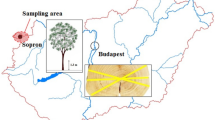Abstract
Thermal analysis can be used for the behaviour of plants during heating and most particularly in the risk prevention of forest fire. Cellulose, holocellulose and lignin are the most important compounds determinated by analytical procedures in six mediterranean vegetals: Acacia dealbata, Pinus halepinsis, Quercus coccifera, Rosmarinus officinalis, Thymus vulgaris, Ulex parviflorus. TG-DTA is applied to the powders obtained after drying (110°C), pounding and sifting. The rate of pyrolysis about 300°C allows a semi-quantitative estimate of the cellulose present in the vegetal and its flammability.
Similar content being viewed by others
Bibliographie
L. Olivier, Thèse de spécialité de l'Université d'Aix-Marseille III, 1975.
C. W. Philpot, Forest Science, 16 (1970) 461.
B. D. Mitchell et A. C. Birnie, Biological materials dans Differential Thermal Analysis, de Mac Kenzie Ed., Academic Press, Londres 1970.
W. K. Tang, Forest products dans Differential Thermal Analysis, de Mac Kenzie Ed., Academic Press, Londres 1970.
J. Kaloustian, A. M. Pauli et J. Pastor, J. Thermal Anal., 46 (1996) 1349.
B. Monties, Les Polymères végétaux, Ed. Gautier-Villars, Paris, 1980.
R. C. Pettersen, Chemical Composition of Wood dans The Chemistry of solid woods, de R. M. Rowell Ed., Advances in Chemistry series, 207, Washington D. C. American Chemical Society, 1984.
Tappi, Acid — insoluble lignin in wood and pulp, Norme TAPPI (Technical Association of Pulp and Paper Industry) T 222 OS-74, (1974).
Viau, F., Analyse chimique et thermique de l'Ulex parviflorus, Rapport de stage MST Méthode et Valorisation de la Chimie Fine, Marseille, 1995.
C. Ballini, Thèse de l'Université d'Aix-Marseille I, 1993.
T. Vo Hong Khanh, Thèse ès-Sciences Pharmaceutiques, Montpellier, 1974.
M. Bernard et N. Nimour, Science Technique Technologie, 26 (1994) 24.
J. Kaloustian, A. M. Pauli et J. Pastor, J. Thermal Anal., 46 (1996) 91.
S. Glassner et A. R. Pierce, Anal. Chem., 37 (1965) 525.
F. J. Kilzer et A. Broido, Pyrodynamics, 2 (1965) 151.
W. H. McClennen, R. M. Buchanan, N. S. Arnold, J. P. Dworzanski et H. L. C. Meuzelaar, Anal. Chem., 65 (1993) 2819.
R. F. Schwenker et L. R. Beck, J. Polymer. Sci., C 2 (1963) 331.
M. Rinaudo, Constituants non protéiques et non lipidiques des graines oléagineuses: composition chimique, propriétés et caractérisation, Revue française des corps gras, 22 (1975) 429.
D. Robert et J. C. Roland, Biologie végétale — Organisation cellulaire, Ed. Doin, Paris, (1989), tome 1.
Author information
Authors and Affiliations
Additional information
Nous tenons à remercier, pour leur collaboration technique, mesdames J. Campocasso, A. Crestin et M. F. Vergnes.
Rights and permissions
About this article
Cite this article
Kaloustian, J., Pauli, A.M. & Pastor, J. Etude comparative par analyses thermique et chimique de quelques vegetaux mediterraneens. Journal of Thermal Analysis 50, 795–805 (1997). https://doi.org/10.1007/BF01979209
Issue Date:
DOI: https://doi.org/10.1007/BF01979209




